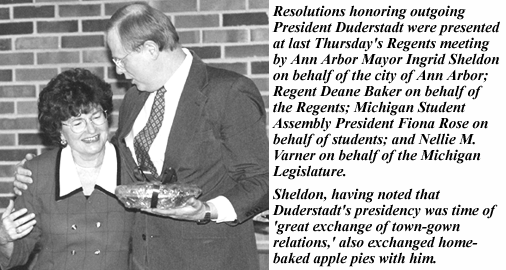The University Record, June 25, 1996
THE DUDERSTADT PRESIDENCY IN RETROSPECT
By Rebecca A. Doyle
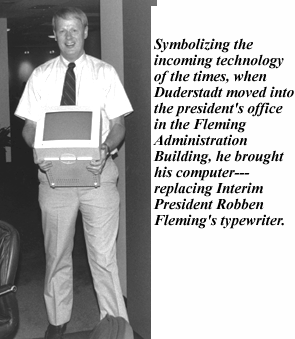 Returning to teaching this fall, President James J. Duderstadt says he and his wife Anne are “looking forward to a move to a more private life.”
Returning to teaching this fall, President James J. Duderstadt says he and his wife Anne are “looking forward to a move to a more private life.”
“It will be nice to unhook this electronic pager,” he said when he talked to The University Record last week.
After 10 years in the U-M’s administrative offices—eight of them as president of the University—Duderstadt will leave the Fleming Building at the end of this week. He plans to return to the faculty this fall, teaching a research seminar for graduate students and faculty on the future of the University, and has plans for courses about new areas of science in the 20th century, a freshman seminar and a technology course that will result in a structure on the WorldWide Web .
 “One of the things I very much missed in the presidency is the opportunity to interact with students,” he says. “My schedule does not allow teaching in the normal sense. I rea lly would like to become re-engaged in the academy. That’s why I became a faculty member in the first place.”
“One of the things I very much missed in the presidency is the opportunity to interact with students,” he says. “My schedule does not allow teaching in the normal sense. I rea lly would like to become re-engaged in the academy. That’s why I became a faculty member in the first place.”
In his eight years as president, Duderstadt said he set goals and used a checklist-like format in strategically planning the directions the U-M should move.
“I never thought five years ago that we would reach this stage,” he says. “Five years ago, the infrastructure was crumbling around us and it seemed we would never be able to renovate and repair the facilities we needed.”
Now, he says, the U-M is “better, stronger and more diverse—we’re better than we’ve ever been before. Financially, it is clear that Michigan is the envy of higher education right now. We needed to position the University for a leadership role in the future in a time of enormous change and transition, and that is what I hope we’ve done.”
Although he has been contacted many times about moving to another institution as president, the Duderstadts decided to stay in Ann Arbor, where they have lived since 1968.
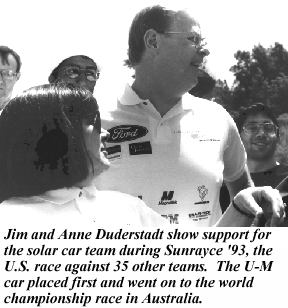 He and A nne have “approached all these roles [at the University] together,” Duderstadt says, noting that the decision to stay in Ann Arbor was a joint one. “There is as much of the Duderstadts in the University of Michigan as there is the University of Michigan in the Duderstadts.
He and A nne have “approached all these roles [at the University] together,” Duderstadt says, noting that the decision to stay in Ann Arbor was a joint one. “There is as much of the Duderstadts in the University of Michigan as there is the University of Michigan in the Duderstadts.
“We have a fondness for the University. In a sense, it is our baby. We want to make sure that all that we and so many other people have put into this institution is protected and the University will continue to survive. This has been our entire career and it will continue to be.”
Anne Duderstadt will continue to be involved in many of the activities that have kept her so busy over the past years. Projects she has begun include work on the History and Traditions Committee, books on the history of the University and outreac h programs.
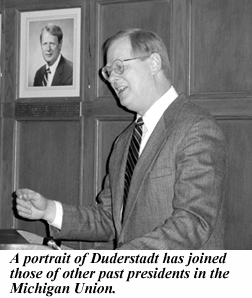 The particular objectives of achieving diversity across the U-M campuses in gender and race, positioning the University’s fi nancial and physical structures at the top, and maintaining academic excellence and leadership were strategic goals on Duderstadt’s checklist 10 years ago, he says. He is proud of the accomplishments the University has achieved under his tenure as presid ent:
The particular objectives of achieving diversity across the U-M campuses in gender and race, positioning the University’s fi nancial and physical structures at the top, and maintaining academic excellence and leadership were strategic goals on Duderstadt’s checklist 10 years ago, he says. He is proud of the accomplishments the University has achieved under his tenure as presid ent:
Financially, the U-M is one of the strongest universities in America—the endowment fund has increased five-fold to $1.6 billion, the Campaign for Michigan reached its $1 billion goal two years ahead of schedule and the U-M became the first public university to receive an Aa1 credit rating from Wall Street.
Capital improvements of more than $1 billion have prepared the U-M to serve the students of the next century with an infrastructure that will support the research and academic interests of the future.
Cost containment, decentralizing financial operations and award-winning programs in total quality management are restructuring the financial and administrative operations of the University.
The Michigan Mandate and the Agenda for Women have helped the U-M reach the highest representati on of people of color and women among students, faculty, staff and leadership in its history.
New initiatives including the Institute for the Humanities, the Media Union, the Institute of Molecular Medicine, the Davidson Institute for Emerging Economies, the Tauber Manufacturing Institute and the Institute for Research on Women and Ge nder have received national recognition.
The high reputation of the U-M’s academic programs has attracted the best in students and faculty, helping the U-M achieve one of the best national rankings for academic programs.
The U-M leads in research dollars from federal, state and corporate sources, last year exceeding $400 million.
|
|
Duderstadt feels confident that he leaves the University in a stable position, well set to lead in the 21st century. The next president of the U-M will have access to a wealth of resources, he says.
But turning those resources over to a new president is “a lot like handing over the keys to a brand-new Ferrari that is capable of going very, very fast,” Duderstadt says. “This institution is vastly more complex. It’s moving sign ificantly faster than it was 10 years ago when I came here. It is a challenge to sit behind the wheel and try to steer it. I think that is going to be a great challenge in the presidential search.” He pointed to the concept of a virtual university that will allow learning from anywhere in the world as one of the fast-moving programs of the immediate future.
Finding someone who can steer the U-M on the right road at high speeds is a task the Regents and the Presidential Search Advisory Committee will find a great challenge, he says.
“They are an outstanding committee, and I am confident they will do as thorough and diligent a job as they can,” he says. “Michigan needs to look at the very best people in higher education. In fact, our credibility will be determ ined in part by our choice. Everyone is looking at us.
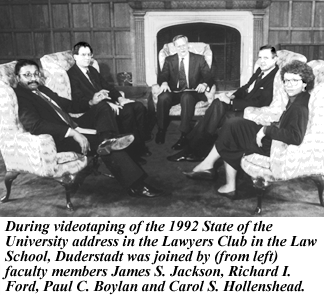 “The University of Michigan presidency is the most complex presidency in the country. As president, you preside over both a system and one of the most complex campuses in the world.”
“The University of Michigan presidency is the most complex presidency in the country. As president, you preside over both a system and one of the most complex campuses in the world.”
While he says he will miss seeing the people he has worked with so closely for so many years, Duderstadt is excited about his involvement with new initiatives and directions for the U-M.
“Obviously, July 1 is a change for me. But it is a change I look forward to.”
Reflecting back on his decision to step down, he says, “I had reached the stage where I felt the next set of transformations that would occur in higher education would be very hard to lead from the traditional university presidency. The real issu es that are going to drive change in higher education and in society are moving very fast. They’re more powerful than most people realize. I think I really need to devote more time and attention to that kind of activity.”
Duderstadt credits the people he says he was privileged to work with as having accomplished much of the work of the past 10 years. He attributes changes in the relationship between students and the administration to Maureen A. Hartford, vice president for student affairs, and the increasingly stable financial environment to Farris W. Womack, executive vice president and chief financial officer.
“I am proudest of what the people around here have been able to accomplish, and that I had a part in attracting and encouraging them,” he says.

